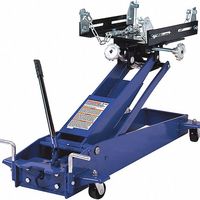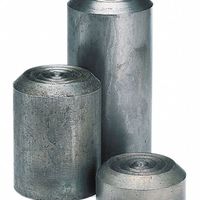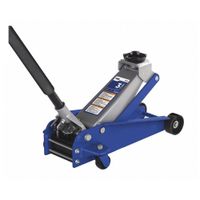Call +(254) 703 030 000 / 751 483 999 / 721 704 777
- Home
- Fleet Vehicle Maintenance
- Garage Equipment
- Vehicle Lifting Support Equipment
- Vehicle Lifting Jacks
Vehicle Lifting Jacks
Lifting jacks raise vehicles or vehicle components and hold them aloft to aid maintenance operations. Service jacks lift a portion of the vehicle frame. Component jacks lift heavy engine parts up and away from the vehicle. Jacks lift using hydraulic, electric, manual, or mechanical force. Jacks have .....Read More
Frequently Asked Questions
What are the different types of lifting jacks for vehicles?
1. **Scissor Jack**: Compact and portable, scissor jacks use a mechanical screw mechanism to lift vehicles. They are commonly included with cars for emergency tire changes.
2. **Hydraulic Bottle Jack**: Shaped like a bottle, these jacks use hydraulic pressure to lift vehicles. They are robust and can lift heavier loads but require more space under the vehicle.
3. **Hydraulic Floor Jack**: Equipped with wheels and a long handle, floor jacks provide stability and ease of use. They are ideal for garages and workshops, offering quick lifting with hydraulic power.
4. **Hi-Lift Jack**: Also known as farm jacks, these are versatile and can lift vehicles with high ground clearance. They are popular among off-road enthusiasts for their ability to lift from various points.
5. **Pneumatic Jack**: Using compressed air, pneumatic jacks can quickly lift vehicles. They are often used in professional settings due to their efficiency and speed.
6. **Electric Jack**: Powered by the vehicle’s battery or an external power source, electric jacks offer convenience with minimal manual effort. They are suitable for those who prefer automated lifting.
7. **Trolley Jack**: Similar to floor jacks but with a wider base and more stability, trolley jacks are used in professional garages for their ease of maneuverability and lifting capacity.
8. **Strut Jack**: Specifically designed for lifting struts or suspension components, these jacks are used in automotive repair shops for suspension work.
9. **Transmission Jack**: Used for removing or installing vehicle transmissions, these jacks have a wide base and adjustable saddle to support the transmission securely.
10. **Exhaust Air Jack**: Inflated by the vehicle’s exhaust, these jacks are useful for off-road situations where a stable lifting surface is not available. They are lightweight and easy to store.
How do hydraulic jacks work?
Hydraulic jacks operate based on Pascal's Principle, which states that pressure applied to a confined fluid is transmitted undiminished throughout the fluid. A hydraulic jack consists of two main components: a pump plunger and a hydraulic cylinder.
When the pump plunger is pushed, it forces hydraulic fluid from a reservoir into the cylinder through a one-way valve. This action increases the pressure within the cylinder. The hydraulic fluid, typically oil, is incompressible, allowing the pressure to be transmitted uniformly.
The cylinder contains a piston, and as the fluid pressure increases, it pushes the piston upward. This upward movement of the piston lifts the load placed on the jack. The mechanical advantage is achieved because the pump plunger has a smaller diameter than the piston, allowing a small force applied to the plunger to lift a much larger load.
To lower the load, a release valve is opened, allowing the hydraulic fluid to flow back into the reservoir. This decreases the pressure in the cylinder, causing the piston to retract under the weight of the load, thus lowering it.
Hydraulic jacks are efficient and capable of lifting heavy loads with minimal effort due to the multiplication of force. They are commonly used in automotive, construction, and industrial applications for lifting vehicles, heavy machinery, and other substantial objects.
What is the difference between a service jack and a component jack?
A service jack and a component jack serve different purposes in various contexts, particularly in automotive and mechanical settings.
A service jack is a tool used to lift vehicles or heavy machinery to facilitate maintenance or repair work. It is designed to provide temporary support and elevation, allowing mechanics to access the underside of a vehicle. Service jacks come in various types, such as hydraulic floor jacks, bottle jacks, and scissor jacks, each suited for different lifting capacities and applications. They are characterized by their portability, ease of use, and ability to lift substantial weights safely.
On the other hand, a component jack is typically used to support or lift individual components or parts of a machine or vehicle rather than the entire structure. Component jacks are often employed in more precise applications, such as aligning or adjusting specific parts during assembly or repair. They are generally smaller and designed for more delicate operations, providing controlled movement and support for components like engines, transmissions, or other mechanical parts.
In summary, the primary difference lies in their application: service jacks are used for lifting entire vehicles or large machinery, while component jacks are used for supporting or adjusting individual parts or components.
How do you safely use a vehicle jack?
1. **Choose the Right Jack**: Use a jack that is appropriate for your vehicle's weight and type. Refer to the vehicle's manual for specifications.
2. **Flat Surface**: Park the vehicle on a flat, stable surface. Avoid soft ground or slopes to prevent the vehicle from shifting.
3. **Engage Parking Brake**: Ensure the parking brake is engaged to prevent the vehicle from rolling.
4. **Wheel Chocks**: Place wheel chocks on the opposite side of the vehicle to further prevent movement.
5. **Locate Jack Points**: Refer to the vehicle's manual to find the designated jack points. Using the wrong spot can damage the vehicle or cause the jack to slip.
6. **Position the Jack**: Align the jack under the jack point. Ensure it is stable and centered.
7. **Lift the Vehicle**: Slowly pump or turn the jack handle to lift the vehicle. Stop once the vehicle is high enough for your needs.
8. **Use Jack Stands**: Once lifted, place jack stands under the vehicle at the recommended support points. Never rely solely on the jack to hold the vehicle.
9. **Lower the Vehicle onto Stands**: Carefully lower the vehicle onto the jack stands by slowly releasing the jack.
10. **Check Stability**: Ensure the vehicle is stable on the stands before working underneath.
11. **Perform Work**: Conduct the necessary maintenance or repairs.
12. **Remove Jack Stands**: Once finished, use the jack to lift the vehicle slightly, remove the jack stands, and then lower the vehicle completely.
13. **Store Equipment**: Safely store the jack and stands after use.
14. **Final Check**: Ensure all tools and equipment are removed from under the vehicle before driving.
What are the best brands of vehicle jacks?
1. **Arcan**: Known for their durable and high-quality hydraulic jacks, Arcan offers a range of floor jacks that are popular for their reliability and ease of use. Their low-profile models are particularly favored for sports cars and vehicles with low ground clearance.
2. **Hein-Werner**: This brand is renowned for its American-made jacks that are built to last. Hein-Werner jacks are often used in professional settings due to their robust construction and dependable performance.
3. **Blackhawk**: Offering a variety of hydraulic jacks, Blackhawk is appreciated for its heavy-duty models that provide excellent lifting capacity. Their jacks are often used in both professional garages and home workshops.
4. **Torin (Big Red)**: Torin is a well-known brand for its wide range of jacks, including bottle jacks, floor jacks, and scissor jacks. They are popular for their affordability and versatility, making them a good choice for DIY enthusiasts.
5. **Pro-Lift**: This brand offers a variety of jacks that are known for their safety features and ease of use. Pro-Lift jacks are often praised for their value for money and are suitable for both light and heavy-duty lifting.
6. **Sunex**: Sunex is recognized for its high-quality, professional-grade jacks. Their products are designed for durability and performance, making them a favorite among mechanics and automotive professionals.
7. **Powerbuilt**: Known for innovative designs, Powerbuilt jacks often include features like all-in-one bottle jack and jack stand combinations. They are appreciated for their practicality and safety features.
8. **Craftsman**: A trusted name in tools, Craftsman offers reliable jacks that are well-suited for home use. Their products are known for their durability and user-friendly design.
How do you maintain and store a vehicle jack?
To maintain and store a vehicle jack properly, follow these steps:
1. **Cleaning**: After each use, clean the jack to remove dirt, grease, and debris. Use a damp cloth and mild detergent if necessary, and ensure it is completely dry before storage to prevent rust.
2. **Inspection**: Regularly inspect the jack for any signs of wear, damage, or leaks, especially in hydraulic jacks. Check for cracks, bent parts, or oil leaks, and ensure all moving parts function smoothly.
3. **Lubrication**: Apply lubricant to the moving parts, such as the wheels, hinges, and lifting arm, to ensure smooth operation. Use a suitable lubricant recommended by the manufacturer.
4. **Hydraulic Fluid**: For hydraulic jacks, check the fluid level periodically. If low, top it up with the recommended hydraulic fluid. Bleed the system to remove any air pockets that may affect performance.
5. **Storage**: Store the jack in a dry, clean environment to prevent rust and corrosion. Keep it in a position that does not stress any components, ideally in its lowest position to relieve pressure on the hydraulic system.
6. **Protection**: Use a cover or case to protect the jack from dust and moisture. If storing for an extended period, consider applying a rust inhibitor.
7. **Safety**: Ensure the jack is stored away from children and in a stable position to prevent accidental tipping or falling.
8. **Manual Reference**: Always refer to the manufacturer’s manual for specific maintenance and storage instructions, as different types of jacks may have unique requirements.
By following these steps, you can extend the lifespan of your vehicle jack and ensure it remains safe and effective for future use.
What accessories are available for vehicle jacks?
1. **Jack Stands**: Provide additional support and stability when a vehicle is lifted, ensuring safety during repairs.
2. **Jack Pads**: Protect the vehicle's undercarriage from damage by providing a cushioned contact point between the jack and the vehicle.
3. **Jack Extensions**: Increase the height range of a jack, allowing it to lift vehicles with higher ground clearance.
4. **Jack Adapters**: Enable compatibility with different vehicle models by adjusting the jack's contact point to fit specific lifting points.
5. **Jack Skid Plates**: Prevent the jack from sinking into soft surfaces like gravel or grass, ensuring stable lifting.
6. **Jack Handles**: Offer better leverage and control, often available in longer or ergonomic designs for ease of use.
7. **Jack Wheels**: Facilitate easy movement and positioning of the jack under the vehicle.
8. **Jack Storage Cases**: Provide a convenient and protective way to store and transport jacks and their accessories.
9. **Jack Oil**: Essential for maintaining hydraulic jacks, ensuring smooth operation and longevity.
10. **Jack Safety Locks**: Secure the jack in place, preventing accidental lowering during maintenance.
11. **Jack Rubber Pads**: Offer additional grip and protection, reducing the risk of slipping and damage.
12. **Jack Cross Beams**: Allow for lifting at multiple points simultaneously, distributing weight more evenly.
13. **Jack Lift Plates**: Provide a larger surface area for lifting, useful for vehicles with unconventional lifting points.
14. **Jack Leveling Blocks**: Help stabilize the jack on uneven surfaces, ensuring a level lift.
15. **Jack Light Attachments**: Illuminate the work area, improving visibility during repairs.
16. **Jack Covers**: Protect the jack from dust and debris when not in use, extending its lifespan.


